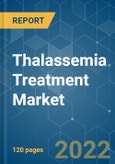The thalassemia treatment market studied was projected to grow with a CAGR of nearly 7.6% over the forecast period. The major factors attributing to the growth of the market are increasing prevalence of thalassemia and also growing awareness to treat thalassemia. According to National Center on Birth Defects and Developmental Disabilities, thalassemia, affects at least 1,000 people in the United States. Furthermore the growing investements in research and development programs by the biotechnology and pharmaceutical companies boosting the market growth. Chelation therapy and blood transfusion are the conventional treatments for thalassemia patients, as these are cost effective and are easily available compared to bone marrow transplantation. Chelation therapy uses drugs such as deferasirox for the treatment of chronic iron overload occurs during multiple blood transfusions among non-transfusion-dependent thalassemia patients. Chelation therapy drugs used subcutaneous or intravenous with slow infusion method for purifying blood, raise the possibility of curing thalassemia in patients. However the high cost of the treatment is major drawback for the market growth.
Key Market Trends
Chelation Therapy segment is expected to be the Fastest Growing Segment
- Iron overload is the main cause of sickness for thalassemia patients. Even non- transfused patients develop iron overload secondary to boosted intestinal absorption of dietary iron. Iron overload is a leading cause of mortality and organ injury. The only treatment options for removing excess iron are phlebotomy and chelation. While phlebotomy is a very effective way of removing iron, it is not appropriate for patients with thalassemia except after bone marrow transplantation.
- The segment is projected to expand at an exponential growth rate during the forecast period. The major factors driving the growth of the segment are increasing incidence of thalassemia patients and increasing research and development investments.
North America Dominates the Market and Expected to do Same in the Forecast Period
North America is expected to dominate the overall thalassemia treatment market, throughout the forecast period. The market growth is due to the factors such as the presence of key players, high prevalence of thalassemia patients in the region and established healthcare infrastructure are some of the key factors accountable for its large share in the market. Furthermore, beneficial government initiatives and increase in number of research partnerships are some of the drivers expected to increase the market growth. The United States has the main share due to the rising awareness about the condition and increasing number of populations with thalassemia carrier gene, and growth in birth rates due to variation of genes among the population.
Competitive Landscape
The thalassemia treatment market is moderately competitive and consists of several major players. Some of the companies which are currently dominating the market Bluebird Bio, IONIS Pharmaceuticals, Novartis AG, Bellicum Pharmaceuticals, ApoPharma Inc, SG Pharma Pvt. Lmt. Acceleron Pharma, Inc., and Kiadis Pharma, Lonza Group Ltd.,
Additional Benefits:
- The market estimate (ME) sheet in Excel format
- 3 months of analyst support
This product will be delivered within 2 business days.
Table of Contents
Companies Mentioned (Partial List)
A selection of companies mentioned in this report includes, but is not limited to:
- Bluebird Bio
- IONIS Pharmaceuticals
- Novartis AG
- Bellicum Pharmaceuticals
- ApoPharma Inc
- Pfizer, Inc.
- Acceleron Pharma, Inc.
- Kiadis Pharma
- SG Phrma Pvt. Lmt.
Methodology

LOADING...








